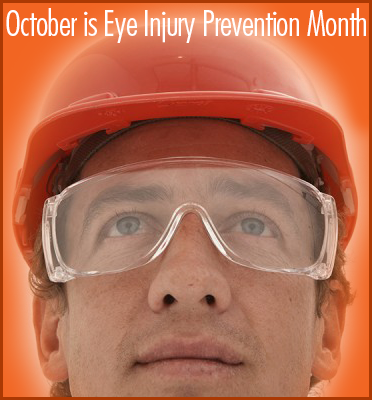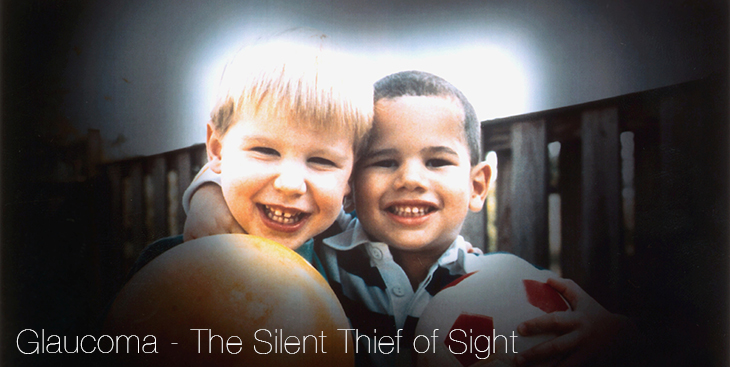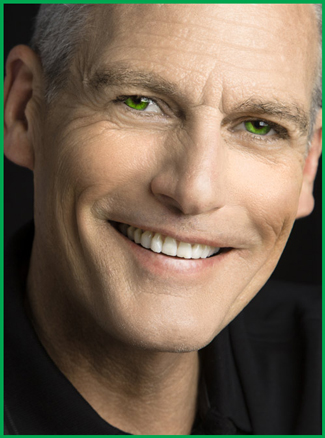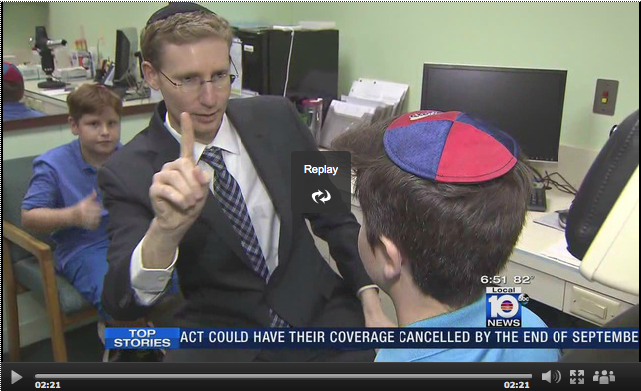October is Eye Injury Prevention Month
Over 2 million people in the United States suffer from eye injuries, annually. Many of these injuries are caused during accidental occurrences, such as car accidents or falls, while others occur due to the negligence of not wearing proper protective eye wear.
As safe as we feel in the comfort of our own home, half of all eye-related injuries happen here. Ninety percent of these injuries could have been prevented or reduced simply by wearing protective eyewear. You can never be too safe when it comes to preserving the health of your eyes and preventing injuries from occurring.
Always take caution while partaking in household activities and chores.
- In the House – When using household chemicals and bleach always read instructions and labels carefully. Be careful while pouring or spraying, because if these chemicals get into your eye it can cause anything from minor irritation to a chemical burn. If this does happen, flush the eye by putting your head under warm running water and rinse the eye out for 15 minutes. Always use these products in a well-ventilated area.
- In the Garden – Wearing protective eyewear while operating a lawnmower, power trimmer or any other type of machinery will prevent objects like grass, rocks and stones from getting into your eye. Also be sure to warn bystanders when using these machines so they are aware of the dangers and take protective measures, as well.
- In the Workshop – Keep your eyes safe by wearing safety goggles while working to prevent flying fragments, fumes, dust particles, sparks and splashing chemicals from entering your eye.
Glaucoma – The Silent Thief of Sight
Did you know that 3 million people in the United States have Glaucoma and half of those people don’t even know they have it?
Glaucoma is the second leading cause of blindness in the United States. The risk of being diagnosed with glaucoma increases if you, have a family history of the disease or are over 65.
There are several types of glaucoma, but they all have one thing in common; damaging the optical nerve in the back of the eye. Normally, fluid called aqueous humor flows out of the eye through a mesh-like channel. If this channel becomes blocked, fluids build up and cause pressure. The high pressure can “push” against the optic nerve and damage it. The peripheral vision is affected first, followed by a reduction in central vision and if not treated in early stages, blindness can occur. This disease gradually destroys your vision so you will hardly notice it is even occurring.
Because glaucoma sneaks up on its victims with no early symptoms or pain, visiting an eye doctor every one or two years is essential for your eye health. Although glaucoma cannot be prevented, blindness from glaucoma can be through early detection and appropriate treatment.
Eye drops, laser therapy and surgery are the conventional treatments and are required if peripheral vision continues to worsen. There are also other ways to aid in the management of this sight stealing disease:
- Reduce alcohol and caffeine intake
- Maintain a healthy diet rich in carotenoids (especially lutein and zeaxanthin), antioxidants (such vitamins C and E), vitamins A and D, zinc and omega-3 fatty acids which all contribute to better vision.
- Exercise 30 to 40 minutes daily
- Lower your insulin levels
- Quit smoking
- Take deep breaths, which will affect your blood pressure and heart rate positively.
- Loosen your tie! A tie that is on too tight compresses the jugular veins, raising interocular pressure and can eventually increase the risk for glaucoma in men.
- Be aware of the medicine you are taking! Prescription drugs for bladder control, seizures, or even certain over-the-counter cold remedies, can increase glaucoma risk.
- Protect your eyes from the sun and during sport activities.
How Can Cataract Surgery Help You?
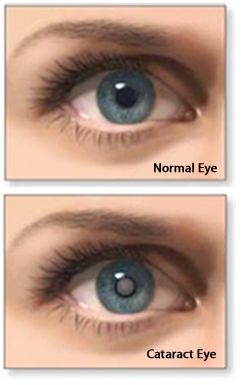 Cataracts are a natural aging process of the eye. By the age of 65 about half of all Americans have developed some degree of a cataract. Most people believe a cataract is a film that grows on the surface of the eye, but in actuality it’s the clouding of the natural lens. Over time and with age, the lens becomes cloudy, causing images to look blurred or fuzzy. At the beginning phrases of a cataract development all that is needed to correct the blurred vision is a pair of glasses or a new prescription. If you experience clouded vision, fading or yellowing of colors, double vision in a single eye, difficulty seeing at night, halos around light or frequent changes in eyeglass prescription, a cataract may have developed in one or both or your eyes.
Cataracts are a natural aging process of the eye. By the age of 65 about half of all Americans have developed some degree of a cataract. Most people believe a cataract is a film that grows on the surface of the eye, but in actuality it’s the clouding of the natural lens. Over time and with age, the lens becomes cloudy, causing images to look blurred or fuzzy. At the beginning phrases of a cataract development all that is needed to correct the blurred vision is a pair of glasses or a new prescription. If you experience clouded vision, fading or yellowing of colors, double vision in a single eye, difficulty seeing at night, halos around light or frequent changes in eyeglass prescription, a cataract may have developed in one or both or your eyes.
If the cataract causes bothersome vision problems and interferes with your daily routine, your ophthalmologist may recommend undergoing surgery to have it removed.
How Can Cataract Surgery Help You?
Today, modern cataract surgery is one of the safest and most successful procedures. The surgery provides patients with both clarity and color of vision, increased independence, an improved quality of life and less dependence on corrective eyewear. Cataract surgery is permanent. In other words, it is impossible for a cataract to come back, because the lens of the eye, where the cataracts grows has been replaced with a new lens that will last a lifetime. During the surgery, the lens in your eye that has become cloudy is removed and replaced with an artificial lens or an IOL to restore clear vision. Your eye doctor will help you choose which IOL is the right fit for you.
What Types of Cataract Surgeries are Available?
Custom Laser Cataract Surgery with LenSx Procedure- The FDA has approved laser cataract surgery as both safe and effect. It works by using optical coherence tomography (OCT) with near infrared light, to produce a digital analysis and computer driven femtosecond laser application. All of the eye structures are displayed in (3D) digital representation continuously, which provides 3D mapping, enabling exact placement within the eye for precise laser application. Doctors can customize the procedure to your unique visual needs to result in better visual outcomes.
Refractive Cataract Surgery- An additional level of care that brings together the latest technology in eye surgeries to help obtain the best possible vision. Refractive cataract surgery can be customized specifically to correct nearsightedness, farsightedness, astigmatism and the reflective aging changes that happen in your eye, all done with the precision of laser.
All eye surgeries are done on-campus in the Rand Surgical Pavillion, a state-of-the-art surgical facility approved by the State of Florida Health Care Administration.
Age-Related Vision Problems
As you age, so do your eyes. You might have trouble reading fine print or need brighter lights in your workspace. Some age-related eye changes are very common and do not signify any sort of disease. Other changes, although still common among senior citizens, can indicate a problem.
1. A cataract is a clouding of the lens, a transparent, layered structure that is found behind the iris. A cataract may begin to form as early as the age of 40 or 50 and can go unnoticed. By 60, the cataract may have advanced enough to cause lower vision. In most cases, people with cataracts can undergo surgical treatment to restore adequate vision.
2. Age-related-macular degeneration destroys the macula, which is a cluster of light-sensitive cells in the center of the retina. The macula is responsible for crisp vision and fine perception of detail. Over 15 million Americans have AMD and it is the leading cause for low vision in those over age 60. Early diagnosis and follow-up appointments with your doctor are essential for preserving vision in people with AMD.
3. Glaucoma is a group of diseases in which the optic nerve begins to damage due to excessive fluid pressure in the eyeball. In people with open-angle glaucoma, the most common type, fluid drainage fails to keep pace with the output. Then, pressure builds on the optic nerve as fluid levels continue to rise. This process occurs so gradually that it may only be noticeable once vision loss has occurred. In some cases, the optic nerve can become so damaged that it is unable to send complete signals to the brain. Those over 60 are at a greater risk for developing glaucoma. Treatment includes medication, laser therapy or surgery.
4. Diabetic Retinopathy is the most common diabetic eye disease and contributes to the leading cause of blindness in elderly Americans. In some people with diabetic retinopathy, blood vessels swell and leak fluid. In other cases, new vessels may grow on the surface of the retina. At first, the changes can go unnoticed, but over time diabetic retinopathy can worsen, causing vision loss. Diabetic retinopathy usually affects both eyes.
5. Presbyopia refers to the farsightedness that develops when the lens of the eye and its surrounding muscles lose their elasticity, causing the muscle fibers to become too rigid to contract or relax properly. As a result, they can no longer focus light well enough to produce clear and crisp vision images. This condition can easily be corrected with reading glasses, bi- or trifocals, contact lenses or surgery.
6. Ptosis describes the droopy, hooded eyelid characteristics that occur with aging. If the drooping becomes too extreme that it causes obscure vision, surgery can be considered.
Rand Eye Institute can assist you in delaying these problems and find the right solution for you.
Healthy Aging Eyes Month
September is Healthy Aging Eyes Month

As we grow older, our sight tends to weaken and we become more at risk for vision problems. Although, we can’t prevent our eyes from aging, we can slow down age-related damage. Follow these tips to ensure healthy eyes while aging:
- Get regular eye checkups- Starting at age forty, you should have obtained a baseline medical eye exam, even if you’re a healthy adult with no vision problems. By 65, eye exams should be scheduled every one to two years, or as recommended by your ophthalmologist.
- Stock up on your fruits and vegetables- Eat right to protect your sight! This means choosing a diet that is rich in fruits and vegetables, especially dark leafy greens. A sufficient intake of the antioxidants lutein and zeaxanthin can help lower the risk of age-related eye conditions. Lutein and zeaxanthin can also be found in fruits and vegetables with yellow-orange pigments, like carrots, squash and citrus fruits.
- Protect your eyes and wear some shades- Shield your eyes from the sun’s ultraviolet rays, which can damage your eyes just as much as they can damage your skin. Too much exposure to UV rays can cause cataracts, so grab a pair before you head out. Wearing a wide-brimmed hat while outdoors for a long period of time will also give you even more protection.
- Give your eyes a break- In order to prevent eyestrain, give your eyes a break from staring at your computer, television, phone, tablet and reading material. Look up or away for 10 seconds every 10 minutes will do the trick. Also, not getting enough sleep is another way to strain your eyes. Refresh your eyes and your entire body by getting some rest.
- Quit smoking- Smoking can promote many eye diseases, because it reduces the blood flow to the eyes and can also increase the amount of toxic substances your eyes absorb, like nicotine and tar. Being at risk for diabetic retinopathy or macular-degeneration, exposure to these types of toxin can elevate that risk even more. If you don’t smoke, stay away from those who do.
- Be aware of your risk factors- Knowing if you are at risk for any age-related eye diseases can do a great deal in preserving your eye sight. Genetic factors, lifestyle choices, diseases and certain exposures can place you in a higher risk category for certain diseases.
Back to School – Dr. David Rand, MD in the News!
Rand Eye Institute’s Dr. David Rand, MD in the News!
Back to School is just around the corner and final preparations under way, but have you scheduled your child’s eye exam?
Be sure to click on the link below to hear from WPLG-Local 10 Health Reporter, Kristi Krueger, the importance of Back to School eye exams.
http://www.local10.com/news/vision-tests-recommended-for-kids-heading-back-to-school/27452116
Parent’s Back to School Vision Checklist
These are formative years for your child, personally and physically. If you have noticed a change in your child’s behavior it may be due to a change in his or her vision. Below is a list of warning signs. If your child demonstrates any of these symptoms, it is advisable to consult your eye care professional.
What to Watch for:
- Child holds reading material too close to face.
- Child sits too close to TV.
- Complains that the writing on classroom blackboard is blurry or too small.
- Missing the ball very often in sports.
- Child complains of double vision.
- Child points to words while reading.
- Writing words or letters backwards could indicate a problem.
- Child complains of headaches.
- Child skips or misses words while reading.
- Child sees better out of one eye than the other.
- Child complains of pain in or around the eye.
Poor hand-to-eye coordination. - Photophobia (bright lights bother eyes).
Dizziness or nausea. - Poor concentration while reading.
- Abnormal head tilt while reading.
- Closes or covers one eye to read.
We’ve all heard this before, and guess what… these are recommended by your caring eye doctors.
Do
- Rest your eyes when they’re tired, especially when working at a computer.
- Wear protective goggles when using power or hand tools.
- Wear sunglasses when outdoors.
- Read in proper lighting.
- Wear your prescribed eyeglasses.
- Flush your eyes with water when dirt or dust gets in your eyes.
- Hold your book approximately sixteen inches away from your face when reading.
Don’t
- Don’t sit close to the TV. Maintain a distance of eight to ten feet.
- Don’t rub your eyes with dirty hands.
- Don’t point sharp objects at anybody’s eyes.
- Don’t look directly into the sun or bright lights.
- Don’t open your eyes under water unless you are wearing protective goggles.
Remember, your child may still have an eye problem even if he or she does not complain or has not shown any unusual signs.
Now is the time to schedule a Back to School Eye Exam.
Children’s Eye Health & Safety Month
Children’s Eye Health & Safety Month/Back to School Eye Health
It’s that time of year again to start packing the lunchboxes and waiting in car lines: BACK TO SCHOOL!
Preschooler. Between the ages of 3 and 3½, a child’s vision and eye alignment should be assessed by a pediatrician, family doctor, ophthalmologist, optometrist, orthoptist or person trained in vision assessment of preschool children.
School age. Upon entering school, or whenever a problem is suspected, children’s eyes should be screened for visual acuity and alignment by a pediatrician, family doctor, ophthalmologist, optometrist, orthoptist or person trained in vision assessment of school-aged children, such as a school nurse. Nearsightedness (myopia) is the most common refractive error in this age group and can be corrected with eyeglasses. If an alignment problem or other eye health issues is suspected, the child should have a comprehensive exam by an Eye M.D.
Summer Safety Tips
Summer’s in full swing! Be safe and protect your eyes while you are out and about in the sun. The Rand Eye Institute wants to assure everyone is taking proper care of their eyes!
View Our Summer Eye Safety Tips:
Celebrating our Seniors
The Rand Eye Institute continues the celebration of Senior Independence Month with the anecdotes of a member of the Rand Eye Institute’s Centennial Club. The video below provides some Personal Tips on living a prosperous and fulfilling life. Don’t let a number stop you from the lifestyle you want.

